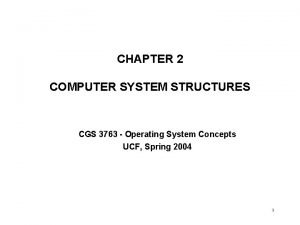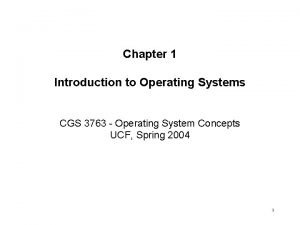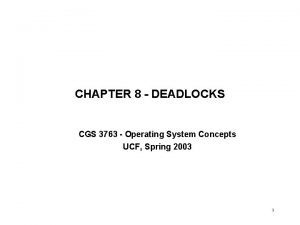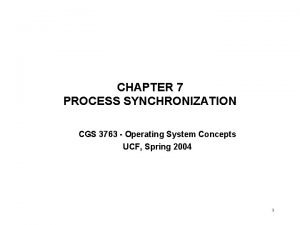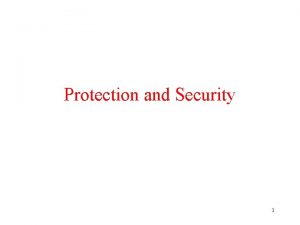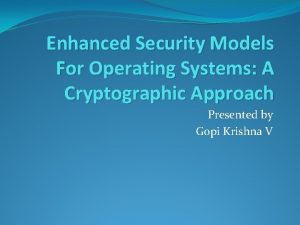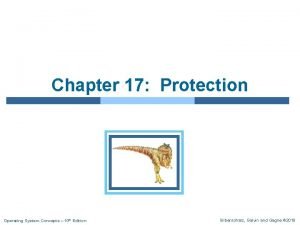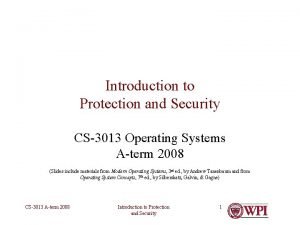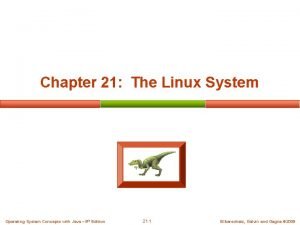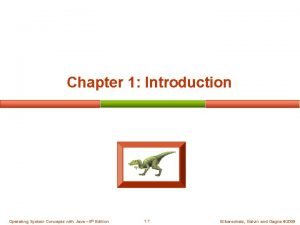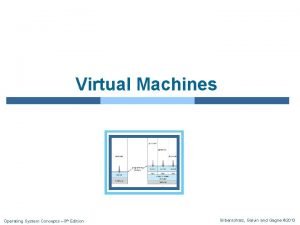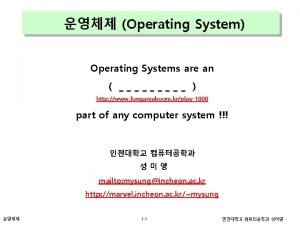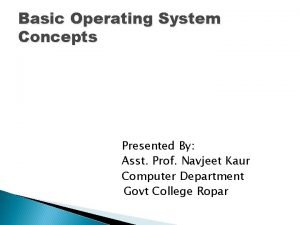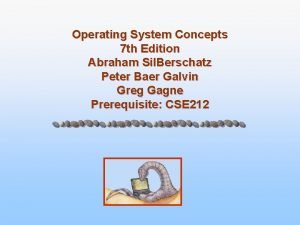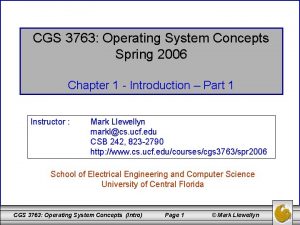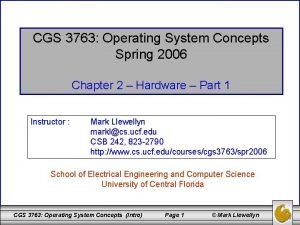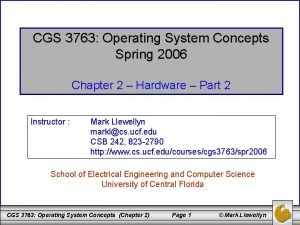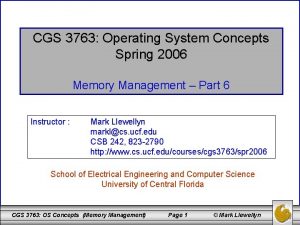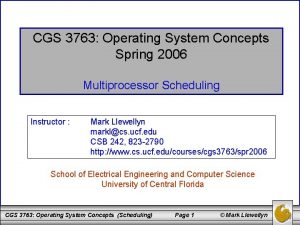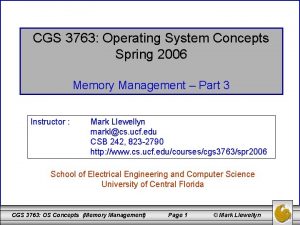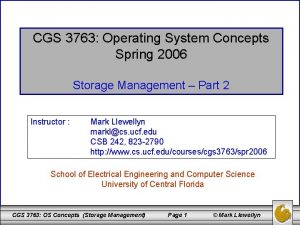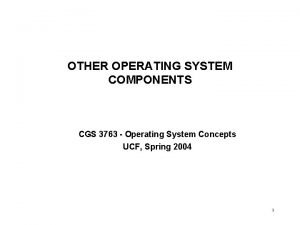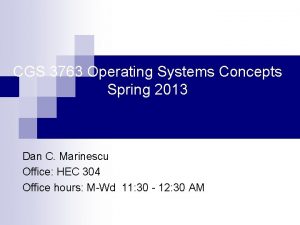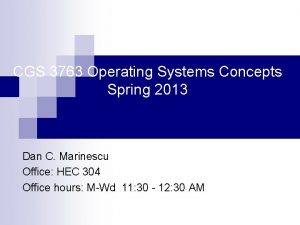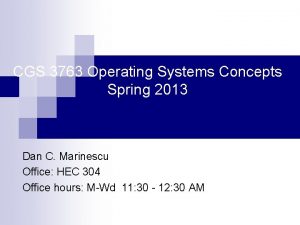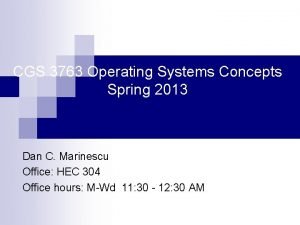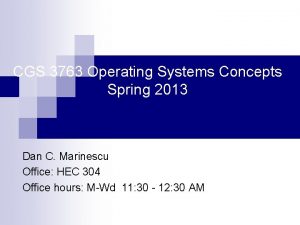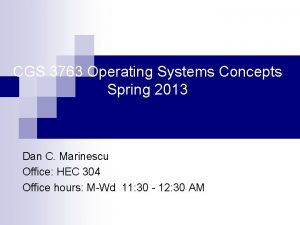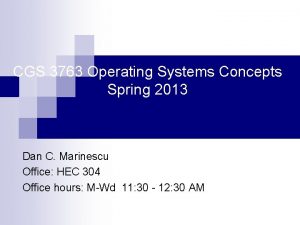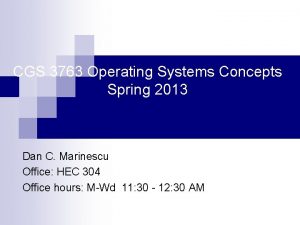CGS 3763 Operating System Concepts Spring 2006 Protection



















- Slides: 19

CGS 3763: Operating System Concepts Spring 2006 Protection Instructor : Mark Llewellyn markl@cs. ucf. edu CSB 242, 823 -2790 http: //www. cs. ucf. edu/courses/cgs 3763/spr 2006 School of Electrical Engineering and Computer Science University of Central Florida CGS 3763: OS Concepts (Protection) Page 1 © Mark Llewellyn

Protection and Security • Operating system consists of a collection of objects, hardware or software. • Each object has a unique name and can be accessed through a well-defined set of operations. • Protection problem - ensure that each object is accessed correctly and only by those processes that are allowed to do so. • Guiding principle – principle of least privilege – Programs, users and systems should be given just enough privileges to perform their tasks CGS 3763: OS Concepts (Protection) Page 2 © Mark Llewellyn

Domain Structure • Access-right = <object-name, rights-set> where rights-set is a subset of all valid operations that can be performed on the object. • Domain = set of access-rights CGS 3763: OS Concepts (Protection) Page 3 © Mark Llewellyn

Domain Implementation - Unix • System consists of 2 domains: – User – Supervisor • UNIX – Domain = user-id – Domain switch accomplished via file system. • Each file has associated with it a domain bit (setuid bit). • When file is executed and setuid = on, then user-id is set to owner of the file being executed. When execution completes user-id is reset. CGS 3763: OS Concepts (Protection) Page 4 © Mark Llewellyn

Access Matrix • View protection as a matrix (access matrix) • Rows represent domains • Columns represent objects • Access(i, j) is the set of operations that a process executing in Domaini can invoke on Objectj CGS 3763: OS Concepts (Protection) Page 5 © Mark Llewellyn

Access Matrix CGS 3763: OS Concepts (Protection) Page 6 © Mark Llewellyn

Use of Access Matrix • If a process in Domain Di tries to do “op” on object Oj, then “op” must be in the access matrix. • Can be expanded to dynamic protection. – Operations to add, delete access rights. – Special access rights: • • owner of Oi copy op from Oi to Oj control – Di can modify Dj access rights transfer – switch from domain Di to Dj CGS 3763: OS Concepts (Protection) Page 7 © Mark Llewellyn

Use of Access Matrix (cont. ) • Access matrix design separates mechanism from policy. – Mechanism • Operating system provides access-matrix + rules. • If ensures that the matrix is only manipulated by authorized agents and that rules are strictly enforced. – Policy • User dictates policy. • Who can access what object and in what mode. CGS 3763: OS Concepts (Protection) Page 8 © Mark Llewellyn

Implementation of Access Matrix • Each column = Access-control list for one object. • Defines who can perform what operation. Domain 1 = Read, Write Domain 2 = Read Domain 3 = Read • Each Row = Capability List (like a key) Fore each domain, what operations allowed on what objects. Object 1 – Read Object 4 – Read, Write, Execute Object 5 – Read, Write, Delete, Copy CGS 3763: OS Concepts (Protection) Page 9 © Mark Llewellyn

Access Matrix With Domains as Objects CGS 3763: OS Concepts (Protection) Page 10 © Mark Llewellyn

Access Matrix with Copy Rights The ability to copy an access right from one domain (or row) of the access matrix to another is denoted by an asterisk appended to the access right. The copy right allows the copying of the access right only within the column (the object) for which the right is defined. A process executing in domain D 2 can copy the read operation into any entry associated with file F 2. This allows the access matrix in (a) to be modified into the matrix shown in (b). CGS 3763: OS Concepts (Protection) Page 11 © Mark Llewellyn

Access Matrix With Owner Rights Domain D 1 is the owner of object F 1 and as such, can add and delete any valid right in column F 1. Domain D 2 is the owner of object F 2 and as such, can add and delete any valid right in column F 2. CGS 3763: OS Concepts (Protection) Page 12 © Mark Llewellyn

Modified Access Matrix of Figure B The control right is applicable only to domain objects. If the control right is available to a domain, it can remove any access right from any domain it controls. In the table shown below, any process executing in domain D 2 can modify domain D 4. Beginning with the access matrix on page 10, we see that the control right has allowed the removal of the read right in domain D 4. CGS 3763: OS Concepts (Protection) Page 13 © Mark Llewellyn

Access Control • Protection can be applied to non-file resources • Solaris 10 provides role-based access control to implement least privilege – Privilege is right to execute system call or use an option within a system call – Can be assigned to processes – Users assigned roles granting access to privileges and programs CGS 3763: OS Concepts (Protection) Page 14 © Mark Llewellyn

Revocation of Access Rights • Access List – Delete access rights from access list. – Simple – Immediate • Capability List – Scheme required to locate capability in the system before capability can be revoked. – – Reacquisition Back-pointers Indirection Keys CGS 3763: OS Concepts (Protection) Page 15 © Mark Llewellyn

Capability-Based Systems • Hydra – Fixed set of access rights known to and interpreted by the system. – Interpretation of user-defined rights performed solely by user's program; system provides access protection for use of these rights. • Cambridge CAP System – Data capability - provides standard read, write, execute of individual storage segments associated with object. – Software capability -interpretation left to the subsystem, through its protected procedures. CGS 3763: OS Concepts (Protection) Page 16 © Mark Llewellyn

Language-Based Protection • Specification of protection in a programming language allows the high-level description of policies for the allocation and use of resources. • Language implementation can provide software for protection enforcement when automatic hardwaresupported checking is unavailable. • Interpret protection specifications to generate calls on whatever protection system is provided by the hardware and the operating system. CGS 3763: OS Concepts (Protection) Page 17 © Mark Llewellyn

Protection in Java 2 • Protection is handled by the Java Virtual Machine (JVM) • A class is assigned a protection domain when it is loaded by the JVM. • The protection domain indicates what operations the class can (and cannot) perform. • If a library method is invoked that performs a privileged operation, the stack is inspected to ensure the operation can be performed by the library. CGS 3763: OS Concepts (Protection) Page 18 © Mark Llewellyn

Stack Inspection CGS 3763: OS Concepts (Protection) Page 19 © Mark Llewellyn
 Cgs 3763 ucf
Cgs 3763 ucf Cgs 3763
Cgs 3763 Cgs 3763
Cgs 3763 Cgs 3763
Cgs 3763 Protection and security in operating system
Protection and security in operating system Security and protection in operating system
Security and protection in operating system Security and protection in operating system
Security and protection in operating system Protection and security in operating system
Protection and security in operating system Operating system concepts, 10th edition
Operating system concepts, 10th edition Linux operating system concepts
Linux operating system concepts Operating system concepts with java
Operating system concepts with java Operating system concepts 6th edition
Operating system concepts 6th edition Operating system concepts 9
Operating system concepts 9 Real time operating system concepts
Real time operating system concepts Operating system concepts 9판 한국어판
Operating system concepts 9판 한국어판 Operating system concepts chapter 8 solutions
Operating system concepts chapter 8 solutions Operating system concepts chapter 5 solutions
Operating system concepts chapter 5 solutions Operating system concepts chapter 5 solutions
Operating system concepts chapter 5 solutions Basic concepts of os
Basic concepts of os Operating system concepts 11th
Operating system concepts 11th
